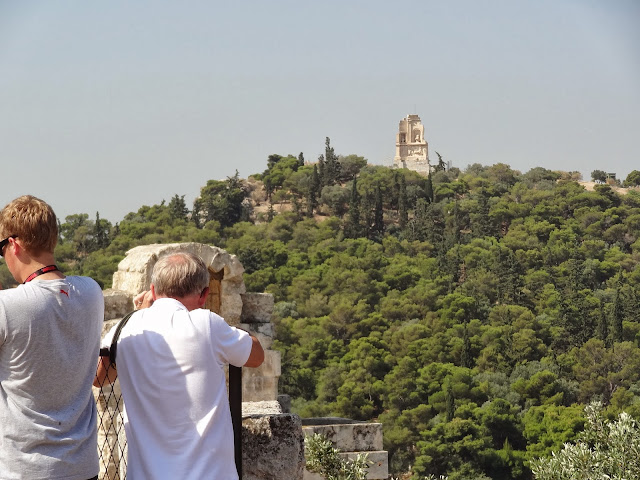By this time in our journey, approximately 14 hours after stepping foot off the airplane and onto Athenian ground, we had ogled the Parthenon from our rooftop dinner table at night, from the steps leading to the Panathenaic Stadium, from the Temple of Olympian Zeus, and from various other vantage points along the way. I couldn't wait to go there!
Onto the bus we hopped, and we were taken on a 5- to 7-minute ride to the bus parking lot for "The Acropolis". A word about "The Acropolis": we learned while we were in Greece that there is really no such thing as "The Acropolis", as we naive Americans have come to so endearingly refer to it. In fact, for many of the cities and communities in Greece, each has its own acropolis. (I was going to phrase that differently, but I don't have any idea the plural form of "acropolis".)
You see, in Greek, "acropolis" means "highest city". It is often a development in or near the center of the community, at a high elevation. "The Acropolis", which we refer to, is actually the "Acropolis of Athens". Contrary to popular thought, it does not consist only of the Parthenon. It is truly a development of various components. And it is freakin' HUGE! And it is wayyyyy up there. Like, many steps up there.
So, we hopped off the bus and headed in the direction of the Acropolis (now, I'm just gonna abbreviate and not type Acropolis of Athens every time. You know what I'm talking about. We're in Athens.) And we walked around a corner and up oh, seven or eight steps, and into the woods on a path. It was like a park. Nice, wooded path. This provided good shade on a hot day.
So we walked. And soon we came to more steps. So we walked up them. And we walked.
And we walked.
And we walked up.
And we walked up some more.
And we came to more steps. And we climbed.
And we walked.
Up.
Some more.
You get the point.
We got to the entrance to the Acropolis and took a quick break for liquid refreshment (some water for us) and a quick restroom break. During our break, Chris took this photo of the Philopappos Monument.
This monument sits high atop Philopappos Hill, just under 1 kilometer to the west of the Acropolis. The Philopappos is a monument and mausoleum dedicated to Gaius Julius Antiochus Epiphanes Philopappos (some prince dude who died in 116 a.d.). It is pretty cool and can be seen from most points in Athens. That's about all I know about the monument or the prince.
So, we grabbed our cool Acropolis tickets and headed to the gates. Whew, we were finally up there, after all that walking and all those steps. Inside the gates, we walked forward and, guess what? More steps. Lots of them. Like 50 or something. But we didn't climb them. Yet.
We took a detour to the right and hiked along another path, overlooking the city of Athens.
Looks a little smoggy, huh?
As we wound along the path, we came upon this.
The Odeum of Herodes Atticus. This is a working theater, and as you can see, they are preparing for an opera to be performed later that week. During the summer, there are weekly musical events in this theater.
This amphitheater, with its near-perfect acoustics may be best known in modern times as the location of Yanni's 1993 performance and audio/video recording "Live at the Acropolis" (which, by the way, is very cool to listen to as I type this blog).
The backdrop stands in ruins, which makes it very cool that it is currently used for performances. I'd love to see anything there. Originally, there was a cedar roof, which is now long gone.
Other famous performances include Sting (sigh) on his Mercury Falling tour in 1996, Elton John times 2 during his 2000 Medusa tour (I wonder if he shuffled across the stage like he did in the Red Piano when I saw him in Vegas in 2007?), and Andrea Bocelli in 2010.
Part of the upcoming opera. Spooky...scary!
A couple of additional photos of the Philopappos Monument from this perspective.
We have several pictures of the monument. It must have really intrigued us.
This is the Temple of Athena Nike.
We will get to see more of it in a few minutes. But for now, do you notice the creamy-colored stone and the white "stone"? The Acropolis is under restoration and has been for several years. Anything you see that is white is "new". The creamy-colored stone is the original stone. The process for restoring the Acropolis is very cool. They are still excavating and finding pieces of the original Acropolis. It's like a giant life-sized jigsaw puzzle. And when there's a missing piece, they just make one!
We'll see more of the contrasting materials in later photos. But for now, remember those 50-ish steps? Let's go climb them. (The Parthenon has to be around here somewhere, and I'd really like to go there one day...)








No comments:
Post a Comment